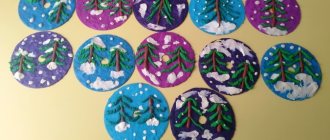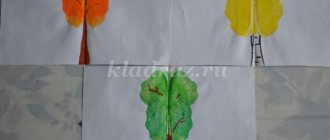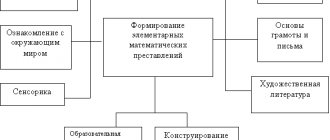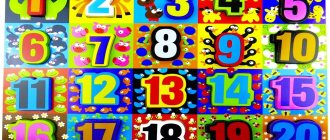Integration of educational areas: cognitive development, speech development, social and communicative development, artistic and aesthetic development, physical development.
Tasks:
"Cognitive development":
introduce a geometric figure - a ball; ordinal number “third”; practice counting up to 3. Activate mental activity through resolving a problem situation. Develop memory, attention, logical thinking. Activate and systematize children’s knowledge and skills.
“Social and communicative development”:
introduce children to the basic rules of interaction with peers in the process of activity, a tolerant attitude towards others, the ability to listen to each other. Create an atmosphere of creative exploration.
"Speech development"
expansion and activation of the dictionary with words: ball, third. Consolidating the use of tree names in speech: birch, oak, spruce, maple.
"Physical development":
improve motor skills.
“Artistic and aesthetic development”:
practice the ability to carefully paint over a silhouette without going beyond the contours of the image.
Methods and techniques:
Practical – games, game exercise;
verbal - conversation, questions, reading a poem;
visual - observations, looking at pictures
Materials and equipment:
demonstration: geometric shapes, a plot picture depicting rectangular objects; a picture depicting objects of different shapes; ball, cube; pictures depicting spruce, birch, oak, ball.
handouts: pictures with silhouette images of trees, colored pencils.
Forms of organizing joint activities
| Children's activities | Forms and methods of organization |
| Visual activities | 1. Task “Paint the tree.” Goal: to consolidate the ability to select the appropriate pencil color to depict parts of a tree. |
| Communication activities | 1. Reading the poem “Ball”. Goal: to be attentive and interested listeners. |
| Cognitive - research | 1. Exercise “Find the ball” Purpose: to consolidate the ability to find objects of the same shape. 2. Game “What to roll?” Goal: teach to think logically by comparing objects. 3. Game exercise “Count the leaves”, “Count the trees”. Goal: to consolidate ordinal counting up to 3, the ability to determine which tree a leaf comes from. |
| Physical activity | 1. Physical education. Goal: activation of motor activity of children. They know how to combine movements with the words of a poem. 2. Sedentary game “Catch and Name” Purpose: to practice catching a ball, to consolidate knowledge of trees. |
Logic of educational activities
| Activities of the teacher | Pupils' activities | Expected results |
| 1. Organizing time. Reviewing what we have learned about geometric shapes Task 1. Includes children in educational activities: Invites them to look at geometric shapes and name them. Task 2. Shows a plot picture and offers to find and name rectangular objects. Task 3. Name any geometric figure. | Show interest in the upcoming topic. Answer questions. They enter into dialogue and offer possible answers. Children name objects that have this shape. | The task is accepted by the children; there is motivation to achieve results in collaboration with the teacher and children. |
| 2. Reading the poem "Ball". I inflate the balloon. I roll it around like a ball, throw it up, and catch it again. I look at his form. It is round, just like a flat circle. But he is a great friend to everyone around. The same shape is an orange, a watermelon, a ball, and a tangerine. I will call the figure that I can roll a ball. | Children listen to a poem. | Interest and desire to listen to the poem are aroused. |
| 3. Exercise "Find the ball." Shows a ball figure. | Children find spherical objects in the picture. | The mental activity of children is activated. |
| 4. Game "What to roll." Draws a line on the floor. Questions: Why does the ball roll faster? Which is more stable: a ball or a cube? | Two children roll a cube and a ball to this line. Children conduct a dialogue with the teacher. Answer questions. | The ability to conduct a coordinated dialogue and be friendly, correct interlocutors has been developed. |
| 5. Counting to 3. Ordinal number “third” . Places 3 pictures of trees (birch, spruce, oak) on the dock. Offers to count the trees and compare their height and thickness. - Name the first tree. (Birch.) - Name the second tree. (Spruce.) - Oak is the third tree. - What kind of tree is birch? - What type of spruce? — What kind of oak? | Children count trees, compare them by height and thickness. Answer questions. | Understand and are able to complete tasks |
| 6. Game exercise “Count the leaves.” He attaches oak, maple, and birch leaves to the board and asks them to name which leaves they are and from which tree. -Which sheet is the first? Second? Third? | They look carefully and name the leaves and answer questions. | Understand and are able to complete tasks |
| 7. Physical education. Offers to play a game, recites a poem: Pine . There is a pine tree in the yard, it reaches towards the sky. Poplar grew up next to her, he wants to be more authentic. A strong wind blew and shook all the trees. The branches bend back and forth, the wind shakes them, bends them. Let's squat together - One, two, three, four, five. We warmed up from the heart and went to the place again. Maple. The wind quietly shakes the maple, tilts to the right, to the left: Once - tilt and twice - tilt, The maple leaves rustled. | Children perform movements and actions behind the teacher. Standing on one leg, stretch - arms up, then do the same while standing on the other leg. Tilts the body back and forth. Hand jerks in front of the chest. Squats. They walk in place. Feet shoulder-width apart, hands behind the head, body tilted to the left, right. | They are able to perform movements and actions for the teacher in accordance with the poetic text. |
| 8. Task “Paint the tree” . Offers each child a picture with a silhouette image of trees. Task: color the second tree yellow, the third green, the first red. | Children sit at tables and complete the task. | They understand and are able to complete tasks. |
| 9. Summary of the lesson. Sedentary game "Catch and name". Throws a ball to each child and asks them to name the tree. Clarifies: which exercise or task was the easiest, most difficult, fun, etc. Makes sure that the children’s answers are complete sentences. | Children catch the ball and say the names of the trees. Children share their impressions of past activities | They know and name the names of trees and can talk about past activities. |
Counting objects within 3. Identifying geometric shapes (square, triangle, circle)
Topic: Counting objects within 3. Definition of geometric shapes (square, triangle, circle)
Integration of educational areas:
Cognition, speech, social-communicative, physical.
Objectives of the priority educational area
:
• consolidate the ability to distinguish between left and right hands and designate them with words: right, left, left. on right;
• consolidate the ability to identify geometric shapes (square, triangle, circle)
• promote the development of visual attention;
• cultivate interest in studying mathematics;
• cultivate independence;
• enrich and activate the vocabulary;
• improve the grammatical structure of speech;
• develop thinking, creative imagination, auditory and visual attention.
Objectives of the educational field in integration:
Practice naming and finding objects of different shapes; practice counting to 3; develop speed of action; improve motor skills.
Exercise your ability to recognize and find geometric shapes: circle, square, triangle...
Strengthen the ability to navigate in space in place of paper: left, right, on, under.
Continue learning to identify colors (red, yellow, blue, green, orange).
Reveal the ability to distinguish concepts denoting signs of the size of an object, using the words “high”, “low”.
To develop in children the ability to purposefully organize their own activities: listen carefully to the teacher’s instructions and act in accordance with them, diligently and in an organized manner to complete tasks.
Prerequisites for educational activities:
Develop organizational skills: name the topic of the lesson: understand the purpose of the task named by the teacher, work according to the plan proposed by the teacher; evaluate the result of the work (it worked - it didn’t work); correct mistakes.
Equipment for the teacher:
geometric figures; a picture depicting objects of different shapes: a ball, a cube; pictures depicting spruce, oak, birch and the same with a silhouette image of these trees; ball.
Equipment for children:
handout counting material.
Introductory part (motivational, preparatory stage)
| Educational field (type of activity) | Forms of work | Educational objectives | Targets (characteristics) |
| Perception, play, artistically aesthetic, socially communicative, cognitive, motor. | Examination of illustrations of work with fairy tale characters. | Practice naming and finding objects of different shapes; practice counting to 3; develop speed of action; improve motor skills. | have a basic understanding of geometric shapes and the composition of numbers up to three; retain the required condition in memory when performing mathematical operations |
Summary of the mathematics lesson “Young Stargazers”. Quantitative and ordinal counting in the middle group
MADO "Kindergarten No. 453"
Teacher Afanasycheva S.V.
Summary of the mathematics lesson “Young Stargazers”.
Quantitative and ordinal counting in the middle group.
Goal: to consolidate children’s knowledge of quantitative and ordinal counting
, names of geometric figures, temporary representations.
Tasks:
— consolidation of knowledge of direct counting within five;
- the ability to find the next and previous number from the named and designated one;
- continue to teach how to correlate numbers with the number of objects;
- distinguish between quantitative and ordinal counting within 5;
- continue to learn how to make a figure from geometric shapes;
- consolidation of knowledge in the names of seasons, time of day, names of geometric shapes.
Progress of the lesson
Introductory part:
A teacher enters dressed as an astrologer, holding a magic wand.
Educator: “Today our room is fabulous, and we will open the door to another, extraordinary, amazing world, which is full of miracles. Only those children who love to travel, fantasize and dream can enter this fairy-tale world. And I will help you with this - today I will be the wise Astrologer from the Planet of Wonders. I have been living on the Planet of Wonders for a long time. Over thousands of years I have seen a lot of unusual and interesting things. I have an old magic book where I write down extraordinary stories and fairy tales (opens the magic book)
.
Listen to a fairy tale. In one star country there lived a king with his star queen and daughter, Princess Zvezdochka. He decided to somehow count everything in his country. He flew, flew through the sky, counted, counted... Returned home, the queen asked - “Well? Have you counted everything?
The king doesn't remember.
The queen got angry, and the king was upset... Then the wise Astrologer tells him... What do you think the Astrologer advised?” (answers and guesses from children)
And the Astrologer tells him: “In order not to forget how many stars, clouds, birds, etc. there are in total, it was necessary to write down those received when counting
numbers using digits.
Recounted and indicated the quantity
. After all, a number is a sign of a number.”
Apparently the king doesn’t even know the numbers! Guys, let's help the king from the Star Country? Now I’ll wave my magic wand and turn you into Astrologer’s assistants and we’ll go to the magical Star Country. “Crible-crable-boom...”
Come quietly into our magical room and sit down at the star tables. After all, you are now young stargazers. And the star country greets us with colored lights.
The king left his portrait, and he is watching you through a celestial telescope. He thinks: will they cope or not?”
GAME “COUNT THE OBJECTS”
Educator: “The king left his cards, apparently he couldn’t count them. Count the objects on the card and indicate the number of objects with a number”
(children count the objects and put the desired number next to them)
.






